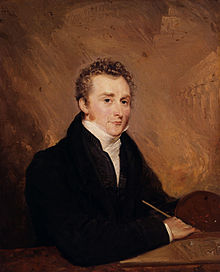John Martin (painter)
English painter, engraver and illustrator (1789–1854)
John Martin (19 July 1789 – 17 February 1854) was an English romantic painter.[1]
John Martin | |
|---|---|
 Portrait of John Martin by Henry Warren, 1839 | |
| Born | 19 July 1789 Haydon Bridge, Northumberland, England |
| Died | 17 February 1854 (aged 64) |
| Known for | Painting, engraving, illustration |
| Movement | Romantic |
| Spouse | Susan |

Biography
changeJohn Martin was born in Haydon Bridge, Northumberland, on 19 July 1789.[2] He was best known as an author of historical paintings. They were mostly inspirated by the Bible and poetical works. Martin's works were usually landscapes with little drawings of people. He was a friend of the poet Edwin Atherstone. They both liked to paint scenes of mass destruction.
After the Belgian government bought The Fall of Ninevah, the Belgian Academy made Martin a member. He also was made a Knight of the Order of Leopold by the king of Belgium.[3]
John Martin died in Douglas, Isle of Man on 17 February 1854.
Works
change(A selection)
- Christ Stilleth the Tempest
- The Calvary
- Belshazzar's Feast (1821)
- The Destruction of Herculanum and Poempeii (1822)
- The Deluge (1826)
- The Fall of Nineveh (1829)
- The Fallen Angels Entering Pandemonium (1841)
- The Last Man (1849)
- The Great Day of His Wrath (1851-1853)
- The Destruction of Sodom and Gomorrah (1852)
- The Last Judgement (1853)
References
change- ↑ John Martin 1789–1854.
- ↑ "John Martin, Biography and image gallery". Archived from the original on 2016-11-30. Retrieved 2016-10-06.
- ↑ John Martin 1789-1854 at Tate.
Bibliography
change- William Feaver, The Art of John Martin, Oxford 1975.